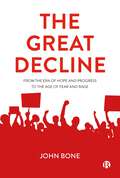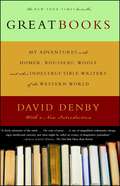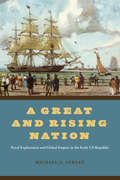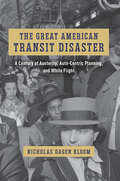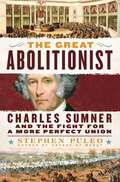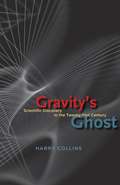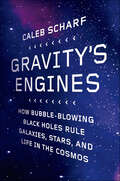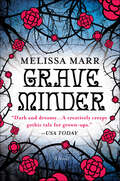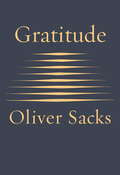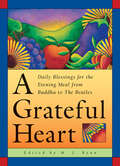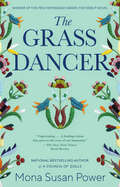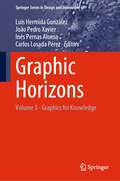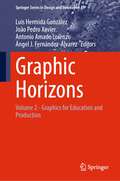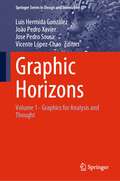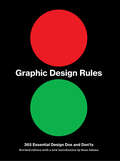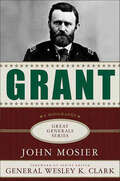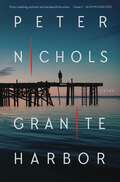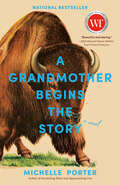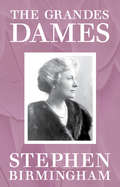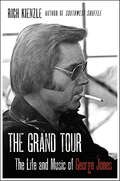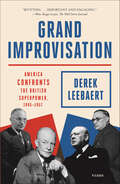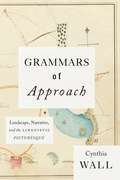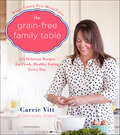- Table View
- List View
The Great Decline: From the Era of Hope and Progress to the Age of Fear and Rage
by John BoneIt seems clear that many formerly stable societies in wealthy developed countries appear to be falling into an apparent state of ‘permacrisis' accompanied by an increasingly angry and irrational social and political culture that is undermining the peace and stability of our societies and democratic institutions, from the local to the global. Applying an original biosocial approach (the social map), and drawing on ideas and evidence from sociology, history and political economy, to psychology, neuroscience and epigenetics, John Bone argues that conditions in our turbocapitalist and increasingly estranged, media dominated societies have created a toxic environment, deeply damaging to our mental and physical health. As well as shedding new light on our current troubles, Bone also outlines why this leaves us ill prepared to deal with two of the greatest challenges confronting humanity: the rise of AI and automation and how we deal with climate change.
Great Books
by David Denby*NATIONAL BESTSELLER* &“A lively adventure of the mind...The tone of the prose...is one of unqualified enthusiasm: energy, vigor, intellectual curiosity, and what might be called an ecstasy of imaginative journalism.&” —The New York Times Book ReviewAt the age of forty-eight, writer and film critic David Denby returned to Columbia University and re-enrolled in two core courses in Western civilization to confront the literary and philosophical masterpieces -- the "great books" -- that are now at the heart of the culture wars. In Great Books, he leads us on a glorious tour, a rediscovery and celebration of such authors as Homer and Boccaccio, Locke and Nietzsche. Conrad and Woolf. The resulting personal odyssey is an engaging blend of self-discovery, cultural commentary, reporting, criticism, and autobiography -- an inspiration for anyone in love with the written word.
A Great and Rising Nation: Naval Exploration and Global Empire in the Early US Republic (American Beginnings, 1500-1900 Ser.)
by Michael A. VerneyA Great and Rising Nation illuminates the unexplored early decades of the United States’ imperialist naval aspirations. Conventional wisdom holds that, until the Spanish-American War of 1898, the United States was a feeble player on the world stage, with an international presence rooted in commerce rather than military might. Michael A. Verney’s A Great and Rising Nation flips this notion on its head, arguing that early US naval expeditions, often characterized as merely scientific, were in fact deeply imperialist. Circling the globe from the Mediterranean to South America and the Arctic, these voyages reflected the diverse imperial aspirations of the new republic, including commercial dominance in the Pacific World, religious empire in the Holy Land, proslavery expansion in South America, and diplomatic prestige in Europe. As Verney makes clear, the United States had global imperial aspirations far earlier than is commonly thought.
The Great American Transit Disaster: A Century of Austerity, Auto-Centric Planning, and White Flight (Historical Studies Of Urban America Ser.)
by Nicholas Dagen BloomA potent re-examination of America’s history of public disinvestment in mass transit. Many a scholar and policy analyst has lamented American dependence on cars and the corresponding lack of federal investment in public transportation throughout the latter decades of the twentieth century. But as Nicholas Dagen Bloom shows in The Great American Transit Disaster, our transit networks are so bad for a very simple reason: we wanted it this way. Focusing on Baltimore, Atlanta, Chicago, Detroit, Boston, and San Francisco, Bloom provides overwhelming evidence that transit disinvestment was a choice rather than destiny. He pinpoints three major factors that led to the decline of public transit in the United States: municipal austerity policies that denied most transit agencies the funding to sustain high-quality service; the encouragement of auto-centric planning; and white flight from dense city centers to far-flung suburbs. As Bloom makes clear, these local public policy decisions were not the product of a nefarious auto industry or any other grand conspiracy—all were widely supported by voters, who effectively shut out options for transit-friendly futures. With this book, Bloom seeks not only to dispel our accepted transit myths but hopefully to lay new tracks for today’s conversations about public transportation funding.
Great Again: How to Fix Our Crippled America
by Donald J. TrumpIn this book (previously published as Crippled America), we&’re going to look at the state of the world right now. It&’s a terrible mess, and that&’s putting it mildly. There has never been a more dangerous time. The politicians and special interests in Washington, DC are directly responsible for the mess we are in. So why should we continue listening to them?It&’s time to bring America back to its rightful owners—the American people. I&’m not going to play the same game politicians have been playing for decades—all talk, no action, while special interests and lobbyists dictate our laws. I am shaking up the establishment on both sides of the political aisle because I can&’t be bought. I want to bring America back, to make it great and prosperous again, and to be sure we are respected by our allies and feared by our adversaries. It&’s time for action. Americans are fed up with politics as usual. And they should be! In this book, I outline my vision to make America great again, including: how to fix our failing economy; how to reform health care so it is more efficient, cost-effective, and doesn&’t alienate both doctors and patients; how to rebuild our military and start winning wars—instead of watching our enemies take over—while keeping our promises to our great veterans; how to ensure that our education system offers the resources that allow our students to compete internationally, so tomorrow&’s jobseekers have the tools they need to succeed; and how to immediately bring jobs back to America by closing our doors to illegal immigrants, and pressuring businesses to produce their goods at home. This book is my blueprint for how to Make America Great Again. It&’s not hard. We just need someone with the courage to say what needs to be said.
The Great Abolitionist: Charles Sumner and the Fight for a More Perfect Union
by Stephen PuleoThe groundbreaking biography of a forgotten civil rights hero.In the tempestuous mid-19th century, as slavery consumed Congressional debate and America careened toward civil war and split apart–when the very future of the nation hung in the balance–Charles Sumner’s voice rang strongest, bravest, and most unwavering. Where others preached compromise and moderation, he denounced slavery’s evils to all who would listen and demanded that it be wiped out of existence. More than any other person of his era, he blazed the trail on the country’s long, uneven, and ongoing journey toward realizing its full promise to become a more perfect union.Before and during the Civil War, at great personal sacrifice, Sumner was the conscience of the North and the most influential politician fighting for abolition. Throughout Reconstruction, no one championed the rights of emancipated people more than he did. Through the force of his words and his will, he moved America toward the twin goals of abolitionism and equal rights, which he fought for literally until the day he died. He laid the cornerstone arguments that civil rights advocates would build upon over the next century as the country strove to achieve equality among the races.The Great Abolitionist is the first major biography of Charles Sumner to be published in over 50 years. Acclaimed historian Stephen Puleo relates the story of one of the most influential political figures in American history with evocative and accessible prose, transporting readers back to an era when our leaders exhibited true courage and authenticity in the face of unprecedented challenges.
Gravity's Ghost: Scientific Discovery in the Twenty-first Century
by Harry CollinsIn theory, at least, gravitational waves do exist. We are constantly bathed in gravitational radiation, which is generated when stars explode or collide and a portion of their mass becomes energy that ripples out like a disturbance on the surface of a serene pond. But unfortunately no gravitational wave has ever been directly detected even though the search has lasted more than forty years.As the leading chronicler of the search for gravitational waves, Harry Collins has been right there with the scientists since the start. The result of his unprecedented access to the front lines of physical science is Gravity’s Ghost, a thrilling chronicle of high-stakes research and cutting-edge discovery. Here, Collins reveals that scientific discovery and nondiscovery can turn on scientific traditions and rivalries, that ideal statistical analysis rests on impossible procedures and unattainable knowledge, and that fact in one place is baseless assumption in another. He also argues that sciences like gravitational wave detection, in exemplifying how the intractable is to be handled, can offer scientific leadership a moral beacon for the twenty-first century. In the end, Gravity’s Ghost shows that discoveries are the denouements of dramatic scientific mysteries.
Gravity's Engines: How Bubble-Blowing Black Holes Rule Galaxies, Stars, and Life in the Cosmos
by Caleb ScharfOne of The Barnes and Noble Review Editors' Picks: Best Nonfiction of 2012Selected by The Christian Science Monitor as one of "21 smart nonfiction titles we think you'll enjoy this summer"Selected by The New Scientist as one of 10 books to look out for in 2012We've long understood black holes to be the points at which the universe as we know it comes to an end. Often billions of times more massive than the Sun, they lurk in the inner sanctum of almost every galaxy of stars in the universe. They're mysterious chasms so destructive and unforgiving that not even light can escape their deadly wrath.Recent research, however, has led to a cascade of new discoveries that have revealed an entirely different side to black holes. As the astrophysicist Caleb Scharf reveals in Gravity's Engines, these chasms in space-time don't just vacuum up everything that comes near them; they also spit out huge beams and clouds of matter. Black holes blow bubbles.With clarity and keen intellect, Scharf masterfully explains how these bubbles profoundly rearrange the cosmos around them. Engaging with our deepest questions about the universe, he takes us on an intimate journey through the endlessly colorful place we call our galaxy and reminds us that the Milky Way sits in a special place in the cosmic zoo—a "sweet spot" of properties. Is it coincidental that we find ourselves here at this place and time? Could there be a deeper connection between the nature of black holes and their role in the universe and the phenomenon of life? We are, after all, made of the stuff of stars.
Graveminder: A Graveminder Novel
by Melissa Marr“No one builds worlds like Melissa Marr.”—Charlaine Harris “Welcome to the return of the great American gothic.” —Del Howison, Bram Stoker Award-winning editor of Dark Delicacies “A deliciously creepy tale that is as skillfully wrought as it is spellbindingly imagined.”—Kelley ArmstrongAnyone who adores dark fantasy, horror, and paranormal suspense is going to love Graveminder, a hauntingly atmospheric tale of the walking dead—and the living who are charged with keeping them at rest—from Melissa Marr, the New York Times bestselling author of the Wicked Lovely series. A young woman returns to the rural small town of her adolescence only to discover it is cursed ground bordering the land of the dead in this spectacularly imagined supernatural tale that will appeal to fans of Charlaine Harris, Joe Hill, Sherrilyn Kenyon, Neil Gaiman, and Carol Goodman.
Gratitude: Essays
by Oliver SacksA deeply moving testimony and celebration of how to embrace life. No writer has succeeded in capturing the medical and human drama of illness as honestly and as eloquently as Oliver Sacks. During the last few months of his life, he wrote a set of essays in which he movingly explored his feelings about completing a life and coming to terms with his own death.&“A series of heart-rending yet ultimately uplifting essays….A lasting gift to readers." —The Washington Post&“It is the fate of every human being,&” Sacks writes, &“to be a unique individual, to find his own path, to live his own life, to die his own death.&” Together, these four essays form an ode to the uniqueness of each human being and to gratitude for the gift of life.&“My predominant feeling is one of gratitude. I have loved and been loved. I have been given much and I have given something in return. Above all, I have been a sentient being, a thinking animal, on this beautiful planet, and that in itself has been an enormous privilege and adventure.&” —Oliver Sacks &“Oliver Sacks was like no other clinician, or writer. He was drawn to the homes of the sick, the institutions of the most frail and disabled, the company of the unusual and the &‘abnormal.&’ He wanted to see humanity in its many variants and to do so in his own, almost anachronistic way—face to face, over time, away from our burgeoning apparatus of computers and algorithms. And, through his writing, he showed us what he saw.&” —Atul Gawande, author of Being Mortal
A Grateful Heart: Daily Blessings for the Evening Meals from Buddha to The Beatles (Daily Blessings For The Evening Meal From Buddha To The Beat Ser.)
by M. J. RyanCelebrate the Human Experience by Giving Thanks at Mealtime. Try It!Count your blessings. Today there is a deep hunger for connection with ourselves, with nature, and with the process of birth and death itself says life coach and author M. J. Ryan, creator of the New York Times best-selling Random Acts of Kindness series. What her book, A Grateful Heart, is offering from a wide variety of spiritual disciplines and secular perspectives, is a way of satisfying that hunger by setting aside time before we eat to acknowledge the blessings in our lives. When we give thanks, we take our place in the great wheel of life, recognizing our connection to one another and to all of creation.Choose from 365 blessings and give thanks. A Grateful Heart is a tool to help readers reclaim and enrich the tradition of pausing before the evening meal to give thanks. Drawing from a range of religious and cultural practices, the 365 blessings in this book celebrate friendship, love, peace, reconciliation, the body, nature, joy, and appreciation of the moment. This illustrated feast for the mind includes quotations from Martin Luther King Jr., Thich Nhat Hanh, Gandhi, Rumi, Mother Teresa, Helen Keller, Denise Levertov, the Bible, and the Tao Te Ching.M. J. Ryan wrote A Grateful Heart to encourage families to share the experience of being part of something greater than themselves. With that in mind, the book includes 365 traditional and nontraditional blessings organized into four sections corresponding to the seasons.Experience the blessings in A Grateful Heart in a variety of ways:Just open it and begin reading one-a-day in the order givenUse the index to pick and choose topics of interest that dayOpen at random and read what is offeredIf you have benefited from books such as Earth Prayers, M. J. Ryan’s Attitudes of Gratitude, Don Miguel Ruiz’s Prayers, June Cotner’s Graces, or Marcia M. Kelly’s 100 Graces; you and your family will love M. J. Ryan’s A Grateful Heart.
The Grass Dancer
by Mona Susan PowerInspired by the lore of her Sioux heritage, this &“captivating&”(New York Times Book Review) critically-acclaimed novel from Mona Susan Power weaves the stories of the old and the young, of broken families, romantic rivals, men and women in love and at war...Set on a North Dakota reservation, The Grass Dancer reveals the harsh price of unfulfilled longings and the healing power of mystery and hope. Rich with drama and infused with the magic of the everyday, it takes readers on a journey through both past and present—in a tale as resonant and haunting as an ancestor's memory, and as promising as a child's dream. WINNER OF THE PEN/HEMINGWAY AWARD FOR DEBUT NOVEL
Grass: ग्रास
by Narayan Dharapनारायण धारप हे नाव आताच्या वाचन करणाऱ्या पिढीला नवीन असलं तरीही त्यांच्या `ग्रास' या पुस्तकातील तारणगावातील उत्तमचंदाचं पिशाचरूप कसं भंडावून सोडतं, कथानकात पुढे काय घडणार याची उत्सुकता कायम ठेवत वाचकाला कसं गुंतवून ठेवायचं याची प्रचीती त्यांच्या रहस्यमय लेखनातून येते.
Graphic Horizons: Volume 3 - Graphics for Knowledge (Springer Series in Design and Innovation #44)
by Luis Hermida González João Pedro Xavier Inés Pernas Alonso Carlos Losada PérezThis book reports on several advances in architectural graphics, with a special emphasis on education, research and heritage. It gathers a selection of contributions to the 20th International Congress of Architectural Graphic Expression, EGA 2024, held on May 27-29, 2024, in Porto, Portugal, with the motto: "Graphic Horizons". This is the third volume of a 3-volume set.
Graphic Horizons: Volume 2 - Graphics for Education and Production (Springer Series in Design and Innovation #43)
by Luis Hermida González João Pedro Xavier Antonio Amado Lorenzo Ángel J. Fernández-ÁlvarezThis book reports on several advances in architectural graphics, with a special emphasis on education, training, and architectural production. It gathers a selection of contributions to the 20th International Congress of Architectural Graphic Expression, EGA 2024, held on May 27-29, 2024, in Porto, Portugal, with the motto: "Graphic Horizons". This is the second of a 3-volume set.
Graphic Horizons: Volume 1 - Graphics for Analysis and Thought (Springer Series in Design and Innovation #42)
by Luis Hermida González João Pedro Xavier Jose Pedro Sousa Vicente López-ChaoThis book reports on several advances in architectural graphics, with a special emphasis on education, training, and research. It gathers a selection of contributions to the 20th International Congress of Architectural Graphic Expression, EGA 2024, held on May 27-29, 2024, in Porto, Portugal, with the motto: "Graphic Horizons". This is the first of a 3-volume set.
Graphic Design Rules: 365 Essential Design Dos and Don'ts
by Tony Seddon Sean Adams Peter Dawson John FosterDON'T use comic sans (except ironically!) but DO worship the classic typefaces like Helvetica and Garamond. Graphic Design Rules is a handy guide for professional graphic designers, students, and laymen who incorporate graphic design into their job or small business. Packed with practical advice, this spirited collection of design dos and don'ts takes readers through 365 rules like knowing when to use a modular grid—and when to throw the grid out the window. All designers will appreciate tips and lessons from these highly accomplished authors, who draw on years of experience to help you create good design.
Grant: A Biography (Great Generals Series)
by John MosierGrant: A Biography tells of the extraordinary life and legacy of one of America's most ingenious military mindsA modest and unassuming man, Grant never lost a battle, leading the Union to victory over the Confederacy during the Civil War, ultimately becoming President of the reunited states. Grant revolutionized military warfare by creating new leadership tactics by integrating new technologies in classical military strategy. In this compelling biography, John Mosier reveals the man behind the military legend, showing how Grant's creativity and genius off the battlefield shaped him into one of our nation's greatest military leaders.
Granite Harbor: A Novel
by Peter NicholsA small town in coastal Maine is shaken to its core by a serial killer in this crime novel from Peter Nichols, bestselling author of The RocksIn scenic Granite Harbor, life has continued on―quiet and serene―for decades. That is until a local teenager is found brutally murdered in the Settlement, the town’s historic archaeological site. Alex Brangwen, adjusting to life as a single father with a failed career as a novelist, is the town’s sole detective. This is his first murder case and, as both a parent and detective, Alex knows the people of Granite Harbor are looking to him to catch the killer and temper the fear that has descended over the town.Isabel, a single mother attempting to support her family while healing from her own demons, finds herself in the middle of the case when she begins working at the Settlement. Her son, Ethan, and Alex’s daughter, Sophie, were best friends with the victim. When a second body is found, both parents are terrified that their child may be next. As Alex and Isabel race to find the killer in their midst, the town’s secrets―past and present―begin bubbling to the surface, threatening to unravel the tight-knit community.At once a page-turning thriller and a captivating portrait of the social fabric of a small town, Granite Harbor evokes the atmosphere of HBO’s Mare of Easttown with a villain reminiscent of Thomas Harris’s Silence of the Lambs.
A Grandmother Begins the Story: A Novel
by Michelle PorterNational BestsellerFinalist for the 2023 Writers' Trust Atwood Gibson Fiction PrizeFinalist for the 2024 Thomas Raddall Atlantic Fiction AwardFive generations of Métis women argue, dance, struggle, laugh, love, and tell the stories that will sing their family, and perhaps the land itself, into healing in this brilliantly original debut novel.Carter is a young mother, recently separated. She is curious, angry, and on a quest to find out what the heritage she only learned of in her teens truly means.Allie is trying to make up for the lost years with her first born, and to protect Carter from the hurt she herself suffered from her own mother.Lucie wants the granddaughter she's never met to help her join her ancestors in the Afterlife.Geneviève is determined to conquer her demons before the fire inside burns her up, with the help of the sister she lost but has never been without.And Mamé, in the Afterlife, knows that all their stories began with her; she must find a way to loose herself from the last threads that keep her tethered to the living, just as they must find their own paths forward.This extraordinary novel, told by a chorus of vividly realized, funny, wise, confused, struggling characters—including descendants of the bison that once freely roamed the land—heralds the arrival of a stunning new voice in literary fiction.
The Grandes Dames
by Stephen BirminghamThe acclaimed social historian provides an in-depth look at eight society women who shaped upper class culture from the Gilded Age to WWII. Astor. Rockefeller. McCormick. Belmont. Family names that still adorn buildings, streets, and charity foundations. While their men blazed across America with their oil, industry, and railways, the matriarchs founded art museums, opera houses, and symphonies that functioned almost as private clubs. Linked by money, marriage, privilege, and power, these women formed a grand American matriarchy—and they ruled American society with a style and impact that make today&’s socialites seem pale reflections of their forbears. Stephen Birmingham takes us into the drawing rooms of these powerful women, providing keen insights into an American society that no longer exists. Caroline Astor, who, when asked for her fare boarding a streetcar, responded, &“No thank you, I have my own favorite charities.&” Edith &“Effie&” Stern deciding that no existing school would do for her child, so she had a new one built. And the legendary Isabella Stewart Gardner replying to a contemporary who was overly taken with their Mayflower ancestors: &“Of course, immigration laws are much more strict nowadays.&” These women had looks, manner, and style, but more than that, they had presence—a sense that when one of them entered a room, something momentous was about to occur; Birmingham opens a window to the highest levels of American society with these profiles of American &“royalty.&”
The Grand Tour: The Life and Music of George Jones
by Rich KienzleIn the vein of the classic Johnny Cash: The Life, this groundbreaking work explores the wild life and extraordinary musical career of “the definitive country singer of the last half century” (New York Times), who influenced, among others, Bob Dylan, Buck Owens, Emmylou Harris, John Fogerty, George Strait, Alan Jackson, and Garth Brooks.In a masterful biography laden with new revelations, veteran country music journalist/historian Rich Kienzle offers a definitive, full-bodied portrait of legendary country singer George Jones and the music that remains his legacy. Kienzle meticulously sifted through archival material, government records, recollections by colleagues and admirers, interviewing many involved in Jones’s life and career. The result: an evocative portrait of this enormously gifted, tragically tormented icon called “the Keith Richards of country.”Kienzle chronicles Jones’s impoverished East Texas childhood as the youngest son of a deeply religious mother and alcoholic, often-abusive father. He examines his three troubled marriages including his union with superstar Tammy Wynette and looks unsparingly at Jones’s demons. Alcohol and later cocaine nearly killed him until fourth wife Nancy helped him learn to love himself. Kienzle also details Jones’s remarkable musical journey from singing in violent Texas honky tonks to Grand Ole Opry star, hitmaker and master vocalist whose raw, emotionally powerful delivery remains the Gold Standard for country singers.The George Jones of this heartfelt biography lived hard before finding contentment until he died at eighty-one—a story filled with whiskey, women and drugs but always the saving grace of music.Illustrated with eight pages of photos.
Grand Improvisation: America Confronts the British Superpower, 1945–1957
by Derek LeebaertA new understanding of the post World War II era, showing what occurred when the British Empire wouldn’t step aside for the rising American superpower—with global insights for today.An enduring myth of the twentieth century is that the United States rapidly became a superpower in the years after World War II, when the British Empire—the greatest in history—was too wounded to maintain a global presence. In fact, Derek Leebaert argues in Grand Improvisation, the idea that a traditionally insular United States suddenly transformed itself into the leader of the free world is illusory, as is the notion that the British colossus was compelled to retreat. The United States and the U.K. had a dozen abrasive years until Washington issued a “declaration of independence” from British influence. Only then did America explicitly assume leadership of the world order just taking shape. Leebaert’s character-driven narrative shows such figures as Churchill, Truman, Eisenhower, and Kennan in an entirely new light, while unveiling players of at least equal weight on pivotal events. Little unfolded as historians believe: the Truman Doctrine and the Marshall Plan; the Korean War; America’s descent into Vietnam. Instead, we see nonstop U.S. improvisation until America finally lost all caution and embraced obligations worldwide, a burden we bear today.Understanding all of this properly is vital to understanding the rise and fall of superpowers, why we’re now skeptical of commitments overseas, how the Middle East plunged into disorder, why Europe is fracturing, what China intends—and the ongoing perils to the U.S. world role.
Grammars of Approach: Landscape, Narrative, and the Linguistic Picturesque
by Cynthia WallIn Grammars of Approach, Cynthia Wall offers a close look at changes in perspective in spatial design, language, and narrative across the late eighteenth and early nineteenth centuries that involve, literally and psychologically, the concept of “approach.” In architecture, the term “approach” changed in that period from a verb to a noun, coming to denote the drive from the lodge at the entrance of an estate “through the most interesting part of the grounds,” as landscape designer Humphrey Repton put it. The shift from the long straight avenue to the winding approach, Wall shows, swung the perceptual balance away from the great house onto the personal experience of the visitor. At the same time, the grammatical and typographical landscape was shifting in tandem, away from objects and Things (and capitalized common Nouns) to the spaces in between, like punctuation and the “lesser parts of speech”. The implications for narrative included new patterns of syntactical architecture and the phenomenon of free indirect discourse. Wall examines the work of landscape theorists such as Repton, John Claudius Loudon, and Thomas Whately alongside travel narratives, topographical views, printers’ manuals, dictionaries, encyclopedias, grammars, and the novels of Defoe, Richardson, Burney, Radcliffe, and Austen to reveal a new landscaping across disciplines—new grammars of approach in ways of perceiving and representing the world in both word and image.
The Grain-Free Family Table: 125 Delicious Recipes for Fresh, Healthy Eating Every Day
by Carrie VittPaleo-friendly meets family-friendly in this beautiful, full-color how-to guide and cookbook that teaches readers how to cut all grains out of their diets without giving up flavorful, delicious food.When Carrie Vitt was diagnosed with an autoimmune disorder, she was put on an elimination diet to cleanse her system that forbid gluten and grains. Failing to find recipes that followed her strict diet guidelines and still were delicious, she began experimenting in her own kitchen. Her organic, grain-free creations not only satisfied her own palate, but pleased friends and family as well. While she eventually reversed her thyroid disease, she continues to champion eating grain free.In this beautiful full-color cookbook, she provides delicious dishes for a workable organic, grain-free lifestyle. Included are a diverse range of recipes for everything from pie crust and homemade nut butter to Pork Carnitas Breakfast Crepe Tacos and Grain-Free Biscuits, Avocado with Mango-Shrimp Salsa, Roasted Garlic Alfredo with Chicken and Vegetables, and Cauliflower “Fried Rice.” Here, too, are kid-friendly recipes such as Squash Macaroni and Cheese, Slice-and-Bake Cookies, and a Classic Birthday Cake with Buttercream Frosting.In addition to sources for healthy ingredients, time-saving ideas, health tips, and 125 easy grain-free recipes, there are also simple dairy-free and Paleo adaptations for each recipe (it’s as simple as choosing coconut oil in place of butter!). Written in Carrie’s warm, inviting style, this helpful sourcebook is the perfect entrée to a healthy, nourishing diet that brings grain-free eating into the mainstream.
